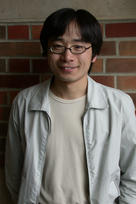Summer School Diaries
Diary of the 2003 Summer School on Theoretical and Computational Biophysics
Thursday, June 5 -- Zhanwu Liu
 Today Dr Emad Tajkhorshid gave lectures on the simulation of membrane
protein. Membrane proteins are very important because many
biological functions are performed at the membrane, but currently the
knowledge of membrane proteins is rather limited. In the first lecture
Emad introduced different types of membrane proteins, mainly different
kind of channels. The second lecture focused on the real example of
SMD simulation using the water channel AQP0, a wonderful work
published in Science last year. Several important points
for simulating a system were mentioned: One should be very
familiar with the system. Not only should one examine the
structure, but one should also check the literature and get new
experimental information.
He then introduced and compared strategies currently used for preparing lipid membrane
systems, and answered how much one can learn from simulations.
Today Dr Emad Tajkhorshid gave lectures on the simulation of membrane
protein. Membrane proteins are very important because many
biological functions are performed at the membrane, but currently the
knowledge of membrane proteins is rather limited. In the first lecture
Emad introduced different types of membrane proteins, mainly different
kind of channels. The second lecture focused on the real example of
SMD simulation using the water channel AQP0, a wonderful work
published in Science last year. Several important points
for simulating a system were mentioned: One should be very
familiar with the system. Not only should one examine the
structure, but one should also check the literature and get new
experimental information.
He then introduced and compared strategies currently used for preparing lipid membrane
systems, and answered how much one can learn from simulations.
"The stereo view creates an astonishing effect: I feel like I've become a small water molecule swimming in the protein."
In the AQP0 study, SMD was used to study the free energy change during transport. The analysis is based on the Jarzynski equation, in which the free energy change can be calculated from non-equilibrium processes.
There is lot of fun in the research. In the movie shown in the lecture, it was very impressive to see the water molecules permeate through the channel in single file, with the orientation tuned to prevent proton transport. The third lecture and the afternoon hands-on session used nanotubes as a model for the channel. Nanotechnology is a hot topic, but I always thought it would be irrelevant for biological systems. It is surprising to see water molecules penetrating into the hydrophobic carbon nanotube. Now I believe nanotubes can be good models for biological systems. In the afternoon, we tried SMD using haptic devices. The stereo view creates an astonishing effect: I feel like I become a small water molecule swimming in the protein. The feedback haptic device gives the direct feeling of the force acting on the molecule; the device is very helpful to understanding details of simulations and constructing better systems to simulate.
In summary, this was a wonderful day. I learnt a lot of science and experienced a lot of fun. Nature is always beautiful at every level of magnification that I can really enjoy!
< Previous | Index | Next >



